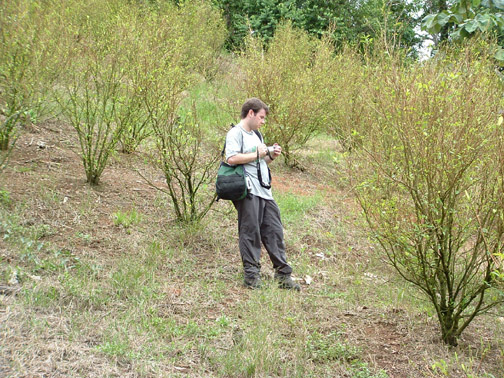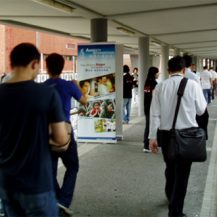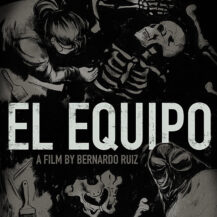Washington Has Lost Its Way in Colombia
Evidence from Putumayo, as well as the streets of U.S. cities, make clear that the fumigation campaign is a monumental failure.
This text originally published: 30 August 2004

Flying into Puerto Asis, in southern Colombia’s Putumayo department, the vastness and denseness of the jungle was striking. As the plane descended, here and there were scattered clearings, ranches and farms cut into the thick green landscape. Around them lay more and more jungle stretching off into the horizon. Moments before landing, the town itself came into view, a concrete and brick oasis amongst the trees, teeming with activity and crass commercialism, much of it the result of fast cash from Puerto Asis’s status as a cocaine trading center. It was February 2004 and my colleague and I were investigating the effects of the U.S.-funded aerial fumigation campaign that has crisscrossed the skies of Putumayo in recent years, spraying an untested cocktail of herbicides and chemical additives over peasant fields amongst the virgin jungle, killing legal and illegal crops alike while reportedly harming the health of animals and humans.
The fumigation campaigns are a much-touted part of the U.S. government’s anti-drug pact with Colombia, dubbed Plan Colombia, which has so far funneled $3.3 billion to the Andean country in just under four years and made it the third largest recipient of U.S. military aid in the world (fourth if counting Iraq). Aerial fumigation, conducted by crop dusters with helicopter gunship support, was supposed to be the silver bullet in the U.S. and Colombian governments’ supply-side fight against illicit coca cultivation. But the evidence on the ground in Putumayo, as well as on the streets of U.S. cities, make clear that the fumigation campaign is a monumental failure.
My colleague and I had no trouble finding coca plots in Putumayo. Just outside the town of Santana, which hosts a Colombian Army base, we crossed an army-guarded bridge over the Putumayo River and boarded canoes with a local campesino. A short way downstream, we scampered up the muddy banks of the river and walked into a field where coca bushes basked in the sunlight allowed in by the clear-cutting of the rainforest canopy. Walking through jungle paths, we came out on another coca patch, and later, yet another. We saw five fields in all, all brimming with coca bushes.
What of the fumigation, we asked the campesino. “They fumigated us six months ago, but the coca grows back quickly. We just harvested again last week. You missed it by a few days.” The campesino went on to explain how planting several varieties of coca bushes—Peruana, Boliviana, Tingo, Punta Roja, and Boliviana Blanca—insured healthy harvests in spite of eradication efforts. He pointed out that the Boliviana Blanca strain, standing up to nine feet tall, was twice as high as other coca bushes. Also, it is particularly resistant to herbicides, and sprouts new light green leaves within days of being harvested.
Writing in the August 27 edition of The Scotsman, BBC correspondent Jeremy McDermott reported similar developments in Colombia’s far northern departments. The article describes a new crossbred, genetically-engineered, herbicide-resistant “super strain” of coca that is yielding four times as many leaves from the same acreage. As Colombian Anti-Narcotics Police Colonel Diego Caicedo, who was in on the discovery, put it, “What we found were not bushes but trees.” McDermott also interviewed a coca grower in Putumayo, who explained that improved coca strains have allowed campesinos to plant ever more compact fields while getting higher yields: “We know the spray planes need a target area of three hectares. Now we just have smaller fields with more intensive farming of the coca bushes.” While it has not been confirmed whether the new “super strain” is actually planted in Putumayo, the bushes my colleague and I saw several months earlier may have been that variety. They were definitely a high-yield variety of coca.
In another sign of the campaign’s ineffectiveness, Colombia’s counternarcotics police estimate that 85 percent of the coca crops they fumigate are immediately replanted. Failing that option, many campesinos move to areas where the fumigation planes are not allowed to spray, like national parks, or to better hiding spots deep in Colombia’s Amazon, beyond the conventional reach of the crop dusters.
In early August, White House Office of Drug Control Policy head John Walters visited Colombia to inspect progress in the “war on drugs.” After flying over fumigated coca fields, the drug czar admitted, “We have not yet seen in all these efforts what we’re hoping for on the supply side, which is a reduction in availability.” A week later, after presumably being set straight by his boss in the White House, Walters sought to clarify his statement when he announced, “In the next 12 months we will see changes in availability of the drug—probably first lower purity, followed by higher prices.”
“We have a history in the United States of not following through on programs like this,” Walters said. He recommended staying the course in Colombia, suggesting that eradication is having the desired reduction effect but that drug traffickers have stockpiled huge cocaine reserves that they are still using to maintain supply. Walters claimed there was a 30 percent reduction in Colombian coca production in the last two years and dismissed evidence of the “squeezed balloon effect” despite rising rates of coca production in Bolivia and Peru, countries long touted as drug war successes by U.S. officials. Left unmentioned by Walters was Ecuador, which has seen coca cultivation take root since Plan Colombia commenced.
But as the Cato Institute’s Ted Galen Carpenter pointed out in response to Walters’ apparent flip-flop, after the Clinton administration initiated Plan Colombia in 2000, “within months U.S. officials boasted about the amount of coca plants… that the aerial spraying campaign was eradicating. Similar claims of success continued until recently” (See State Department Report Delivers a False Positive). This stay-the-course-despite-no-reduction-in-availability mentality is a cornerstone of U.S. drug war policy no matter which party controls the White House. Indeed, given decades of Washington’s failed interdiction efforts, Walters’ claim that just one more year should really put a dent in the drug trade has an even more hollow ring than U.S. Defense Secretary Donald Rumsfeld’s pre-invasion prediction that Iraqis would embrace U.S. troops with smiles and flowers.
But drug czar Walters is far from the only politician lost on the inside-the-beltway Möbius strip. In a Washington Times commentary on August 25, the State Department’s Assistant Secretary for the Bureau of International Narcotics and Law Enforcement Affairs, Robert Charles, chastised the National Geographic editors and Chilean photojournalist Carlos Villalon for an investigative article entitled “Cocaine Country” that appeared in the magazine’s July 2004 issue. Based on three years of research, Villalon’s photo essay and brief report gave a rare and valuable glimpse into the lives of many thousands of Colombians who live in a remote part of the approximately 40 percent of the Colombian territory controlled by the country’s largest guerrilla group, the Revolutionary Armed Forces of Colombia (FARC). The article fit clearly within the magazine’s longstanding tradition of balanced ethnographic journalism.
But for Assistant Secretary Charles, National Geographic’s editors “should have known that they could be seen as lending credibility to those who supply drugs that kill more than 21,000 Americans each year and fund terrorism in our hemisphere.” In condemning the magazine’s coverage of FARC-run areas, Charles alluded to the State Department’s list of Foreign Terrorist Organizations (FTOs), of which the FARC is one member. In his editorial, Charles complained bitterly that Villalon’s article portrayed the FARC as “benevolent,” rather than as an “incalculable evil,” and that Villalon was guilty of “disturbing” omissions concerning the FARC’s role in bombings, kidnappings, drug trafficking, and other crimes. While few observers deny the FARC’s role in the aforementioned activities, these were clearly not the focus of Villalon’s work.
Nonetheless, by running through a litany of FARC crimes and opining, “inexplicably, there was little mention of this” in the National Geographic article, Charles brought the argument to a national level and committed his own egregious omission in the process. Noticeably absent from Charles’ one-sided tirade was any mention of another group on the State Department’s FTO list: the United Self-Defense Forces of Colombia (AUC). This right-wing paramilitary group has repeatedly committed crimes every bit as heinous as those of the FARC, if not more so. Charles’ own State Department estimates the AUC are responsible for 70 percent of the country’s human rights abuses, and the U.S. Drug Enforcement Agency’s Karen Tandy recently told Congress that the AUC are “inextricably linked to the drug trade.” The mysteriously vanished former AUC leader Carlos Castaño once admitted that 70 percent of the group’s funding came from the drug trade, and the United States has outstanding drug-related indictments and extradition requests on several of the group’s current leaders.
Since Assistant Secretary Charles felt it acceptable to take a respected magazine to task for its editorial decision by claiming it lent credibility to the FARC, spare a moment to consider how the following act, condoned by Washington’s anti-drug allies in Bogotá, could possibly be viewed as anything but granting unwarranted legitimacy to the AUC. On July 28, AUC commanders Salvatore Mancuso, Ramon Isaza, and Ivan Roberto Duque were flown by a Colombian Air Force plane to Bogotá, where government vehicles whisked them to the Colombian Congress so that they could speak, at length, about the “heroic” deeds they had performed for Colombia. The event was sanctioned by President Alvaro Uribe, who granted the trio a two-day safe conduct pass so that they could avoid being arrested on the multiple outstanding warrants and extradition requests against them.
Considering the numbers of innocent civilians killed by the group these three command, this event was akin to President Bush inviting Osama bin Laden and his cadre to address the U.S. Congress, then returning them to their safe haven abroad. Instead of crying foul over Bogotá’s pandering to wanted criminals, the Bush administration is now contemplating using some $150 million in U.S. taxpayers’ money to pay for the amnesty and demobilization of thousands of AUC combatants as part of Uribe’s half-baked peace negotiations (which, by virtue of not including the country’s main insurgency, the FARC, will not achieve peace). Given that, on paper, Washington considers the AUC a terrorist organization on par with the FARC or al Qaeda, where would such a move leave the president who once suggested that “Either you are with us or you are with the terrorists”?
As the Colombian case makes clear, fighting drugs at their source is proving to be an exercise in futility. But if history is any indicator, we shouldn’t expect the facts to get in the way of Washington’s zealotry. Meanwhile, the Bush administration has contradicted its own anti-terror rhetoric by selectively supporting negotiations with a group on the State Department’s foreign terrorist list. Without doubt, inconsistencies in the war on drugs and terror are becoming increasingly apparent.
Notes
Image: Author Eric Fichtl under Boliviana Blanca coca bushes. Photo: Garry Leech
This article originally appeared in Colombia Journal, an online journal that was published by the Information Network of the Americas (INOTA).


